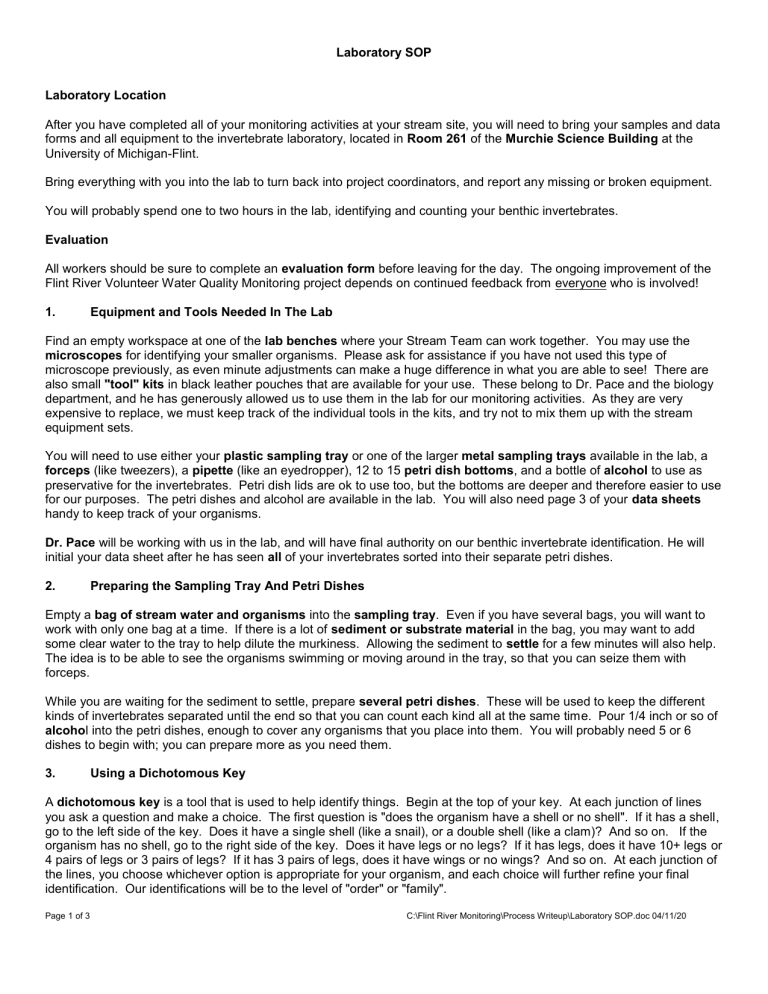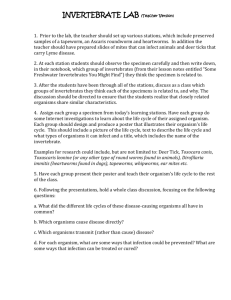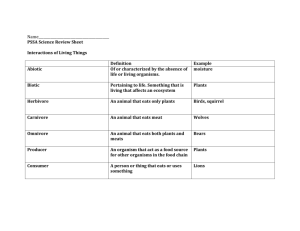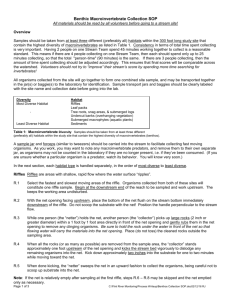Laboratory SOP

Laboratory SOP
Laboratory Location
After you have completed all of your monitoring activities at your stream site, you will need to bring your samples and data forms and all equipment to the invertebrate laboratory, located in Room 261 of the Murchie Science Building at the
University of Michigan-Flint.
Bring everything with you into the lab to turn back into project coordinators, and report any missing or broken equipment.
You will probably spend one to two hours in the lab, identifying and counting your benthic invertebrates.
Evaluation
All workers should be sure to complete an evaluation form before leaving for the day. The ongoing improvement of the
Flint River Volunteer Water Quality Monitoring project depends on continued feedback from everyone who is involved!
1. Equipment and Tools Needed In The Lab
Find an empty workspace at one of the lab benches where your Stream Team can work together. You may use the microscopes for identifying your smaller organisms. Please ask for assistance if you have not used this type of microscope previously, as even minute adjustments can make a huge difference in what you are able to see! There are also small "tool" kits in black leather pouches that are available for your use. These belong to Dr. Pace and the biology department, and he has generously allowed us to use them in the lab for our monitoring activities. As they are very expensive to replace, we must keep track of the individual tools in the kits, and try not to mix them up with the stream equipment sets.
You will need to use either your plastic sampling tray or one of the larger metal sampling trays available in the lab, a forceps (like tweezers), a pipette (like an eyedropper), 12 to 15 petri dish bottoms , and a bottle of alcohol to use as preservative for the invertebrates. Petri dish lids are ok to use too, but the bottoms are deeper and therefore easier to use for our purposes. The petri dishes and alcohol are available in the lab. You will also need page 3 of your data sheets handy to keep track of your organisms.
Dr. Pace will be working with us in the lab, and will have final authority on our benthic invertebrate identification. He will initial your data sheet after he has seen all of your invertebrates sorted into their separate petri dishes.
2. Preparing the Sampling Tray And Petri Dishes
Empty a bag of stream water and organisms into the sampling tray . Even if you have several bags, you will want to work with only one bag at a time. If there is a lot of sediment or substrate material in the bag, you may want to add some clear water to the tray to help dilute the murkiness. Allowing the sediment to settle for a few minutes will also help.
The idea is to be able to see the organisms swimming or moving around in the tray, so that you can seize them with forceps.
While you are waiting for the sediment to settle, prepare several petri dishes . These will be used to keep the different kinds of invertebrates separated until the end so that you can count each kind all at the same time. Pour 1/4 inch or so of alcoho l into the petri dishes, enough to cover any organisms that you place into them. You will probably need 5 or 6 dishes to begin with; you can prepare more as you need them.
3. Using a Dichotomous Key
A dichotomous key is a tool that is used to help identify things. Begin at the top of your key. At each junction of lines you ask a question and make a choice. The first question is "does the organism have a shell or no shell". If it has a shell, go to the left side of the key. Does it have a single shell (like a snail), or a double shell (like a clam)? And so on. If the organism has no shell, go to the right side of the key. Does it have legs or no legs? If it has legs, does it have 10+ legs or
4 pairs of legs or 3 pairs of legs? If it has 3 pairs of legs, does it have wings or no wings? And so on. At each junction of the lines, you choose whichever option is appropriate for your organism, and each choice will further refine your final identification. Our identifications will be to the level of "order" or "family".
Page 1 of 3 C:\Flint River Monitoring\Process Writeup\Laboratory SOP.doc 04/11/20
Laboratory SOP
Page 2 of 3
It may be tempting to jump to the bottom of the key and simply look for pictures that look similar to your organism.
However, you may miss an important attribute of the organism along the way that could make a difference in your identification. The key to the dichotomous key is patience! With practice, you will become adept at the identification process, and in fact will know what to look for at the first glance.
4. Sorting the Organisms
After the sediment has settled in your sampling tray, start searching for invertebrates . Many of the larger kinds will probably be very obvious to you. Other smaller kinds will hide underneath leaves or other debris in your tray. You may have to chase some kinds around your tray!
There are several tools to help catch them. You can seize them with forceps - being careful not to accidentally dismember them - and then place them into the alcohol in the petri dish. If they are too small to use forceps, you can draw them into a pipette , expelling most of the excess water very carefully back into the sampling tray while keeping the organism inside the pipette, and then expelling the organism into the alcohol in the petri dish.
As you look at each organism to identify it, you may find you need to use the microscope to be able to see if a particular attribute is present or absent. Please ask for assistance in adjusting the microscope the first time, as it will make a huge difference in what you are able to see.
Use the dichotomous key to decide what each organism is, and then place each different kind into a separate petri dish.
Accuracy is important, so don't be afraid to ask for help if you are unsure of your identification! Again, Dr. Pace is available to help you, as are other volunteers and workers in the lab. We all learn something new every time!
After you have found all of the organisms that you can see in your sampling tray, empty the leftover contents of the tray into the bucket that is available for that purpose (NEVER empty a tray into a sink! The sand and debris will clog the drain), and empty the next baggie of stream water into the tray, and begin the process again.
If you transported some of your invertebrates (for example, invertebrate predators) from the stream to the lab in their own separate jars, you can identify them and then put them straight into the alcohol in the petri dishes. These obviously do not need to go into the sampling trays first.
There are a few organisms on the dichotomous key that are not represented on your data sheet, meaning they "don't count" towards the final index score. This is because these organisms can survive and reproduce in either polluted or non-polluted conditions. Knowing that these organisms are present therefore does not indicate the health of the stream, because they can survive and reproduce anywhere.
Other things that "don't count " on the data sheet are organisms or parts of organisms that were not alive when you collected them, and that are not alive when you arrive at the lab! This is why it's important not to dismember the organisms when catching them. While it's true that we do kill the organisms by placing them into alcohol before storing them, they must be alive when they arrive at the lab to be counted. Dead invertebrates do not indicate healthful conditions in a stream, because we have no way of knowing how they died.
Exceptions to this are for crayfish and clams . Stream Teams should not collect any live crayfish at the stream site, but only count the number of live ones seen and note their number on the data sheet. No more than one live clam should be brought back to the lab. Again, workers should count the total number of live clams seen, but should try not to disturb clams if they are lodged in the substrate. If both shell-halves of a dead clam are found still attached together, then you may leave all the live specimens of the same species in the stream. The numbers of live crayfish and clams seen do count toward the final index score.
5. After You Have Sorted the Invertebrates
After you have identified all of your organisms, you will count each different kind. Any kind with 11 or more counts as a
"common" kind, and gets a "C"; any kind with 10 or less counts as a "rare" kind and gets an "R". You will count the number of "C"s and the number of "R"s for each group, following the directions on page 3 of your data sheet, to tally your final stream-health index score for your stream site.
Dr. Pace will then check your petri dishes to make sure they contain what you think they contain. After he is sure that your identification and all final counts are correct, he will initial your data sheet.
Laboratory SOP
Page 3 of 3
After Dr. Pace has initialed your data sheet, you may place all of your invertebrates together into one final jar that has been filled 2/3rds full with alcohol. A label will be provided for your jar with the date, and name and location of the stream.
The invertebrates are preserved in rubbing alcohol so that they may be sent to the Michigan Department of
Environmental Quality (MDEQ) along with copies of the data sheets for each site. There the samples are checked once again for identification accuracy, and are kept as a permanent record for that stream site location and time. MDEQ biologists may even further identify the invertebrates to the level of "species" , affording them even more information about the conditions of the stream. The MDEQ uses the information gathered from volunteer monitoring activities to supplement their own fieldwork and studies.
6. Before You Leave - Evaluate!
Before you leave us for the day, please take a few moments to complete an evaluation form , and make sure that all of your equipment is turned back in to the project coordinators.
Thank You!
Thank you for your hard work and commitment to the Flint River Volunteer Water Quality Monitoring project!








